
Full text loading...
Our study shows that time-lapse changes in the amplitude of the seismic reflection at an oil–water contact (OWC) and/or produced OWC can be used to estimate directly the displacement efficiency of water displacing oil, E D, without the need of a rock and fluid physics model. From this value, it is possible to determine the remaining oil saturation if required. A preliminary application is performed using several published literature examples, which are reinterpreted to assess the average E D and ensure that the theory is consistent with expectations. Next, a North Sea field model with a known E D is used to create fluid-flow predictions and the corresponding synthetic time-lapse seismic data. Application to these data again confirms the basic principles of the method and defines the accuracy when applied to 4D seismic data. Finally, an observed 4D seismic dataset from a producing field in the North Sea is analysed. The results suggest a displacement efficiency of between 21 and 65% with an accuracy of 3% due to data non-repeatability (with a NRMS of between 11 and 13%). Given an average irreducible water saturation of 0.32, this calculates the remaining oil saturations at between 24 and 53% for this field. A prerequisite for use of the proposed OWC approach is that a discrete contact be interpreted on either the 3D or 4D seismic datasets. Therefore, successful application of this technique requires moderate- to high-quality seismic data and a fairly thick reservoir sequence without significant structural complexity.

Article metrics loading...

Full text loading...
References


Data & Media loading...

